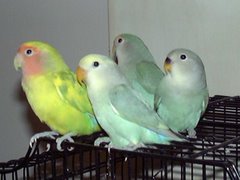You may be frowned why there is a need for such a topic in this blog. It is not a secret- just like that if you know how to find a
right dog seller, it is more or less equal- choosing a
right lovebird seller.
When purchasing a dog, it is important to do so from a reputable seller. You should for instance stay clear of puppy mills and unskilled backyard breeders, since such breeders frequently promote poor
dog health in their puppies.
A puppy mill owner will for instance often refrain from spending any money on nutritious food and veterinary car for the dogs, since the aim of the puppy mill is to generate as much money as possible.
An unskilled backyard breeder might very well love her dogs, but without sufficient knowledge about dog health, hereditary dog disease and so on, it is easy to unknowingly promote poor dog health in the puppies, e.g. by using unsuitable dogs as parents. The risk of being offered a puppy from a puppy mill or backyard breeder is higher for some breeds than others.
If you wish to purchase a rare dog breed such as Ariégeois, Iceland shepherd or Hungarian
Vizlsa, you are unlikely to be offered a puppy from a puppy mill since the owners of such establishments tend to focus on really popular breeds that are easy to sell.
If you on the other hand want to purchase some of the most popular breeds, e.g. Collie, German Shepherd or Golden Retriever, you are very likely to see adds and other forms of advertising from puppy mills.
In addition to these traditional breeds, the increased popularity of
miniature dog breeds such as
Chihuahua, Papillon and
Pekingese have made tiny dogs a new and profitable target for puppy mill owners interested in making some quick and easy money.









 Free Ads For Bloggers
Free Ads For Bloggers

